11,2km hike in La Bastide-Puylaurent |
Take the train from La Bastide Saint Laurent les Bains station (SNCF Timetables) to Chasserades. Upon exiting the station, turn right onto the D6, then 350 meters further, turn right again, cross the railway tracks, and take the path on the left. Follow this path to the Croix de Peyre, then continue straight on the small communal road to the Croix de Grabio. Take the diagonal path on the right and rejoin the small road by passing next to the Dolmen of Thort or Palet de Gargantua. Cross the small hamlet of Thort and walk along the D906 for 200 meters. Take the path on the right which descends to the old D906 road. Turn left and follow this abandoned road for 1.8 km. Climb left onto the track that crosses the D906 and reach the cemetery, then the parking lot behind the church. Turn left twice towards the multipurpose hall and cross the Allier via the footbridge.

4km - 11km - 11,2km - 14km - 15,5km - 16,3km - 19km - 21,5km - 23,2km - 24km
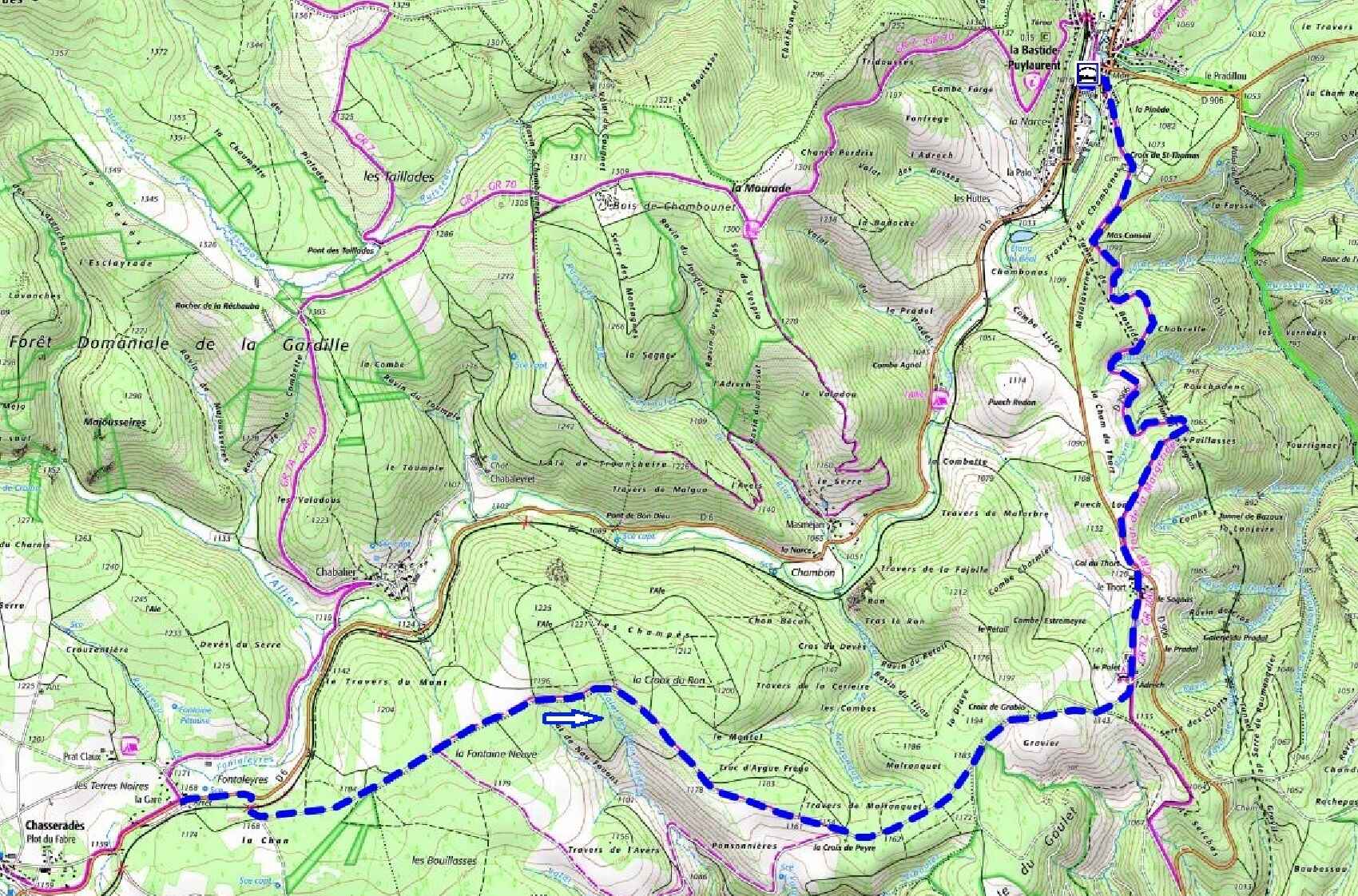

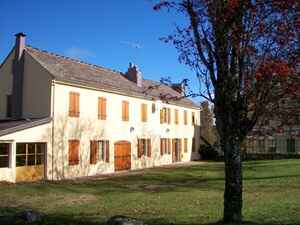
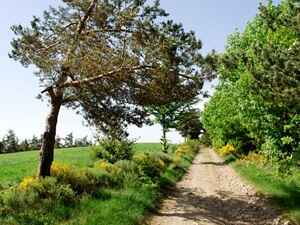
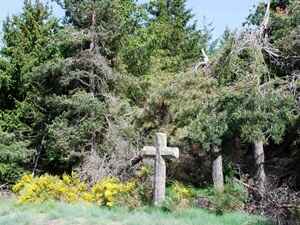
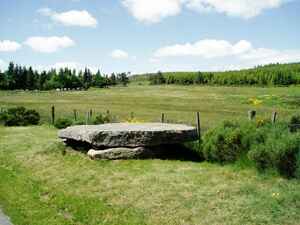
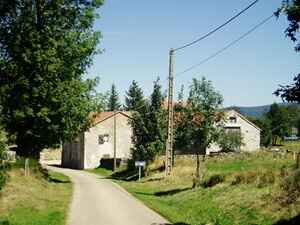

Distance: 11.2 km, Maximum altitude: 1196 m, Minimum altitude: 1016 m, Total elevation gain: 89 m
IGN Maps: La Bastide-Puylaurent (2738E), Largentiere La Bastide-Puylaurent Vivarais Cevenol (2838OT).
Human habitation in the region dates back to at least protohistory. Although the huts have left no traces, the domen du Thort has been there since 1800 or 2100 BC. It is the "Palet de Gargantua". The road was then traced on the high plateaus of Thort, Molette and Garde-Guerin. It was cut into the schist on the slopes of the Ceze valleys. In the villages, houses were built on large warehouses that opened onto the main street through ogival doors, remains of which can be seen in Genolhac in the Gard. Vehicles, small in size and carrying barely more than 500 kilograms because of the materials used to build them, circulated there. A song of gesture, the Charroi de Nîmes, in the second half of the 12th century, evokes this country of Regordane where there are "carts and carts in profusion", char et charretes i a à grant plante (v.950). If this is so, it is because in this period, the climate, similar to the one we know, is favorable to the growth of plants. The harvests are abundant and wealth is created that must circulate. It is a prosperous era that offers itself the luxury of building cathedrals that we would be hard pressed to sketch. Without schist, carts with a track of 1.40 meters dig ruts by their passage repeated a hundred times, like these wooden clogs that end up wearing away the stone of the threshold of the house.
Chasserades, a small village in the Cevennes in Lozere, is known for its historical heritage and its exceptional natural environment. With around 200 inhabitants, it attracts visitors with its mountain and forest landscapes ideal for outdoor activities such as hiking. The village is crossed by the Stevenson Trail and served by a picturesque train line linking Mende to La Bastide-Puylaurent, which passes over the Mirandol viaduct and offers spectacular views of the Chassezac gorges. Chasserades' heritage includes the imposing Saint-Blaise church, a 12th-century Romanesque building listed as a Historic Monument. This monument, originally dedicated to Notre-Dame, bears witness to the local religious history and is distinguished by its massive architecture, comparable to that of La Garde-Guerin. Also nearby are the remains of Mirandol castle, a former medieval lordship. The local fauna and flora are rich and diverse, offering the opportunity to observe deer, wild boar, wolves, lynx, birds of prey and many species of birds. Chasserades is also a popular place for trout fishing, mushroom picking, and bike rides. Finally, Chasserades welcomed Robert Louis Stevenson in 1878, during his famous journey with his donkey Modestine. The village today retains this peaceful and authentic atmosphere, making it a destination of choice for lovers of nature and tranquility.
Holiday memories in Chasserades are marked by friendliness and shared activities. Upon arrival in this picturesque village, the warm welcome from the locals and loyal friends, as well as the joyful reunions, created a family atmosphere. Between the hikes guided by Mr. Esposito, the football and rugby games in the Bois de la Cure, and the explorations of the surrounding area – forests, rivers and mountains – each day brought its share of adventures and discoveries. Summers were also punctuated by traditions such as the pilgrimage to Notre-Dame-des-Neiges, fishing, forest hunts, and picking arnica, cherries, and mushrooms. The August 15 ball was the high point of the summer season, bringing together villagers and holidaymakers around dances and bingo, and creating unforgettable moments. The social life of the village, marked by local figures, the petanque competition, and evening gatherings enlivened by Fernand Claveroli's funny stories, strengthened the bonds between everyone. For young people, Chasserades represented a place of freedom, initiation, and first experiences, such as smoking in secret or embarking on their first flirtations. These holidays, invariably renewed each year, have remained for everyone a sanctuary of happy and intense memories, where every corner and every face evokes the carefree nature and emotions of adolescence.
Former holiday hotel with a garden along the Allier, L'Etoile Guest House is located in La Bastide-Puylaurent between Lozere, Ardeche, and the Cevennes in the mountains of Southern France. At the crossroads of GR®7, GR®70 Stevenson Path, GR®72, GR®700 Regordane Way, GR®470 Allier River springs and gorges, GRP® Cevenol, Ardechoise Mountains, Margeride. Numerous loop trails for hiking and one-day biking excursions. Ideal for a relaxing and hiking getaway.
Copyright©etoile.fr